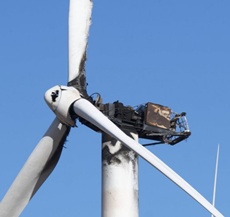Fires are major cause of wind-farm failure, according to new research
19 Jul 2014
Wind farming is one of the leading industries in the renewable energy sector. However, the industry faces a number of challenges, such as opposition by wind farm lobbyists.
 A new research suggests that incidents of wind turbines catching fire are a big problem that is not currently being fully reported.
A new research suggests that incidents of wind turbines catching fire are a big problem that is not currently being fully reported.
Researchers from Imperial College London, the University of Edinburgh and SP Technical Research Institute of Sweden carried out a global assessment of the world's wind farms, which contain an estimated 200,000 turbines combined.
The team found that ten times more fires occur than are being reported. Instead of an average of 11.7 fires each year, which is what is reported publicly, the researchers estimate that more than 117 separate fires are breaking out in turbines annually.
By comparison, with other energy industries, fire accidents are much lower in frequency in wind turbines than other sectors such as oil and gas, which globally has thousands of fire accidents per year.
However, fire accidents can have a considerable economic impact on the wind farm industry, says the team. Each wind turbine costs in excess of £2 million and generates an estimated income of more than £500,000 per year. Any loss or downtime of these valuable assets makes the industry less viable and productive.
The researchers make a number of recommendations to reduce fire incidents in wind farms.
Dr Guillermo Rein, from the Department of Mechanical Engineering at Imperial College London, says, ''Wind turbines are viable sources of renewable energy that can assist the world to reduce emissions and help wean us off fossil fuels.
However, fires are a problem for the industry, impacting on energy production, economic output and emitting toxic fumes. This could cast a shadow over the industry's green credentials. Worryingly our report shows that fire may be a bigger problem than what is currently reported.
Our research outlines a number of strategies that can be adopted by the industry to make these turbines safer and more fire resistant in the future.''
Wind turbines catch fire because highly flammable materials such as hydraulic oil and plastics are in close proximity to machinery and electrical wires. These can ignite a fire if they overheat or are faulty.
Lots of oxygen, in the form of high winds, can quickly fan a fire inside a turbine. Once ignited, the chances of fighting the blaze are slim due to the height of the wind turbine and the remote locations that they are often in.
Since the 1980s, when wind farms were first constructed, the team found that fire has accounted for 10 to 30 per cent of reported turbine accidents. In 90 per cent of the cases, the fire either leads to substantial downtime or a total loss of the wind turbine, resulting in economic losses.
The researchers also outline the main causes of fire ignition in wind turbines in the study. They are, in decreasing order of importance - lightning strike, electrical malfunction, mechanical failure, and errors with maintenance.
Reports of fires in wind farms are increasing, say the researchers. However, the true extent of these fires has been hard to assess because official reports about fires are either incomplete, biased or contain not publically available.
In an effort to get a clearer picture about the true extent of fires in wind farms, the team carried out an extensive analysis of data from a wide range of sources. This included government reports, data from anti-wind farm lobbyists and information gathered by major newspaper investigations.
The researchers suggest a number of measures that can be put in place to prevent fires from happening. These include ''passive'' fire protection measures such as installing comprehensive lightning protection systems.
Other measures include using non-combustible hydraulic and lubricant oils and building heat barriers to protect combustible materials.
Manufacturers are also advised to avoid using combustible insulating materials and apply new monitoring systems to constantly check the condition of machinery so that maintenance work can be carried out in a timely way.
The researchers also suggest a number of ''active'' fire protection measures that can be used to stop a fire before it takes hold or gets out of control. These include smoke alarm systems inside the turbine, so that fire safety authorities can be alerted rapidly. The team also suggest suppression systems that quickly douse the flames in water or foam.
In the future, the team aim to study the impact of fire in other renewable energy technologies such as solar panels.
The research has been published in the journal Fire Safety Science.






























